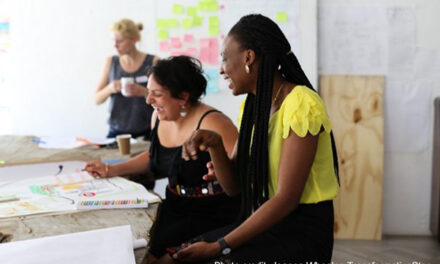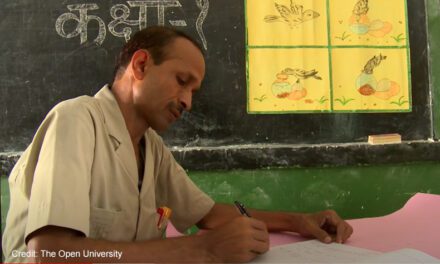In this UKFIET Blog, Mike Douse outlines how, in purposive partnership, learners, teachers and AI might best achieve new levels of creative originality, having fun as they do so.
Artificial Intelligence (AI) has highlighted the issue of plagiarism, with Large Language Models (LLM) overwhelming education at all levels as the incessant AI cheating versus detection battle rages on. Teachers wonder whether they are grading students or computers. Learners, enjoying the duality of contemporary consciousness, and happily merging the virtual with the tangible, find it all too easy to pass off a ChatGTP essay as their own.
Accusations – and debates regarding the definition – of plagiarism go back to classical times, if not earlier. Ancient Greek critics distinguished the acceptable ‘imitation’ of earlier writers (mimēsis) from the unacceptable ‘theft’ involving derivative copying (klopē). A whole tradition of writers, “from Archilochus to Plato, are praised for their re-use of Homer” whereas “Cicero has M. Pupius Piso indict the Stoics for plagiarising (or ‘kidnapping’) philosophical ideas from the Peripatetics”.
Two centuries ago, the Reverend Charles Caleb Colton observed that “If we steal thoughts from the moderns, it will be cried down as plagiarism; if from the ancients, it will be cried up as erudition”. To Wallace Notestein, a Professor of English History at Yale University, is attributed the prevalent aphorism: “If you copy from one book, that’s plagiarism; if you copy from many books, that’s research”. Much as the great Tom Lehrer chaunted: “Don’t shade your eyes, but plagiarise, plagiarise, plagiarise – only be sure always to call it research”. [These two opening paragraphs have ‘drawn’ from no fewer than nine sources, five of which I have acknowledged].
AI has the potential to significantly reduce plagiarism by improving detection methods and providing tools to help users create original content. Advanced algorithms can compare vast amounts of text to identify similarities and flag potential plagiarism more accurately than traditional methods. However, completely eliminating plagiarism is challenging. It requires not only technological solutions but also educational efforts to promote academic integrity and ethical behaviour. AI can assist in these efforts by offering writing assistance, citation tools, and educational resources to help users understand and avoid plagiarism. [This third paragraph was written by a machine. Through force of habit, I would have avoided the split infinitive.]
Producing their ‘own’ essays – ranging from fifth-graders’ ‘My Favourite Pet’ through to doctoral theses – practices learners in researching, thinking and writing. Working out what you believe, and justifying it in an organised, well-illustrated and convincing way, is a product of putting together your own essay. As Professor John Noughton puts it, this is why the “process of writing is so good for the intellect. It forces one to figure out lines of argument that are coherent, choose evidence that is relevant, find sources of information and inspiration that are useful, and – most importantly – learn the craft of expressing yourself in sentences that are readable and clear”.
But if the task is seen as no more than putting together sets of sentences in an acceptable fashion, learners will readily farm it out – if how you get there is seen as unimportant, then let that labour be outsourced. In terms of immediate tactics, let it be recognised, that essay writers have always drawn upon available sources, whether they be teachers, books, colleagues, libraries, family members, print and visual media, the swot of the class, the orator in the park or internet searches. LLMs, although raising the level of support very significantly, are similar in kind: “tools for human augmentation, not replacement” (ibid). As that great sage and omelette, Humpty Dumpty, put it: “The question is which is to be master”.
Schools and universities should, of course, guide students in the effective and ethical use of all such support sources extending to (a) citation, (b) using AI as an assistant in order to enhance the content creation process rather than replacing it, and (c) applying a plagiarism detector. Not only should doing this avoid copyright infringements, checking for plagiarism in, say, newspaper articles or political speeches – as an individual assignment or as a class exercise – may provide an entertaining insight into assessing the benefits and pitfalls of applying AI tools, in proper or in unscrupulous ways.
But those important approaches are no more than tactical in that they address current school and university arrangements and fail strategically to respond to education’s forthcoming fundamental transformation. As has been addressed elsewhere, today’s technology, notably AI, is necessitating and enabling wholesale change. A key aspect of these profound developments involves letting the learners (from secondary onwards) lead, with teachers coming into their own in providing expert support, facilitation of learning and personalised encouragement – but no longer involved in controlling, accrediting, punishing or being the sole founts of knowledge. Learners in driving seats, receiving feedback on their essays for each one’s individual benefit – rather than being assessed and graded – will have no reason to outsource the work to an LLM, any more than an athlete would get a machine to do her gym work or a food critic to replace him in a restaurant.
Accordingly, in the current educational context, the proposed tactics involve imaginative teaching regarding the use of AI – and all other available augmentation sources – in creative partnership, including checking one’s own, one another’s, and published work for plagiarism, and discussing the implications. More strategically, recognising education’s fast approaching revolution, with the learner leading and the teacher supporting, the motivation to misuse AI disappears. A secondary student choosing to understand Creative Essay Writing, for example, will have no reason to outsource to Yomu any more than a 70-year-old seeking to master Spanish Language and Culture would invite a machine to learn on her behalf.
In both short and medium terms, both tactically and strategically, AI may be mobilised in the learner’s support, immediately through imaginative teaching and, subsequently, in the provision of guidance (upon request) to learners with agency choosing to demonstrate originality and creativity as they explore this fascinating post-digital world.





